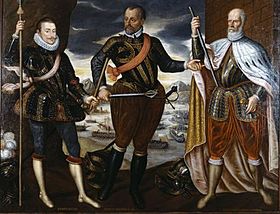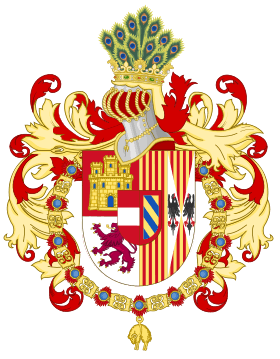John of Austria facts for kids
Quick facts for kids
John of Austria
|
|
|---|---|
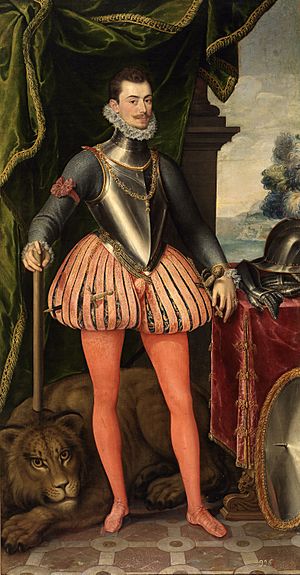
Oil in canvas, 2nd half of 16th century, probably by Juan Pantoja de la Cruz.
Museo del Prado, Madrid. |
|
| Born | 24 February 1547 |
| Died | 1 October 1578 (aged 31) Bouge near Namur
|
| Parent(s) | Charles V, Holy Roman Emperor Barbara Blomberg |
| Signature | |
 |
|
John of Austria (Spanish: Juan, German: Johann; 24 February 1547 – 1 October 1578) was a famous military leader. He was the son of Holy Roman Emperor Charles V. John served his half-brother, King Philip II of Spain, as a military commander. He is most famous for leading the Holy Alliance fleet. This fleet won a major victory at the Battle of Lepanto.
Life of John of Austria
Early Years and Family
John of Austria was born in Regensburg, a city in Germany, on February 24, 1547. His mother was Barbara Blomberg, a singer. His father was Emperor Charles V. Charles V was a very powerful ruler in Europe.
In 1554, when John was a young boy, he was taken to live in Spain. He lived with Luis de Quijada and his wife, Magdalena de Ulloa. They took good care of his education. He learned Latin and other important subjects.
Emperor Charles V officially recognized John as his son in his will. He asked that the boy be renamed John. This was to honor Charles's mother, Queen Joanna of Castile. The Emperor also wanted John to become a priest.
After Charles V died, his son Philip II became king. Philip II was John's half-brother. In 1559, Philip II met John for the first time. Philip II told John that they were brothers. John was given the title Don Juan de Austria. He was treated with respect, but not like a royal prince.
Growing Up and Early Challenges
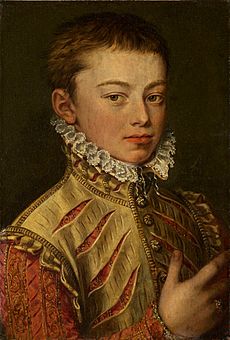
John of Austria continued his education at the University of Alcalá de Henares in Spain. He studied there with his nephews, Prince Carlos and Alessandro Farnese. They were all close in age. John was preparing for a career in the church, as his father had wished.
John also took part in important court events. For example, he carried his nieces, Philip II's daughters, to their baptisms.
In 1565, the Ottoman Empire attacked the island of Malta. John wanted to join the Spanish navy to help defend it. King Philip II did not give him permission. But John was determined. He traveled to Barcelona, hoping to join the fleet. However, he arrived too late. He only returned to court after a letter from his brother, the King.
Later, Prince Carlos told John about his plan to run away from Spain. Prince Carlos wanted to go to the Spanish Netherlands. He asked John for help to get a ship. John told the King about Prince Carlos's plans. This showed John's loyalty to his brother, Philip II.
John later took command of a fleet in the Mediterranean Sea. For three months, he sailed along the coast of North Africa. He fought against pirates, known as corsairs.
The Alpujarras Rebellion
In 1567, a new law was made in Spain. It forced the moriscos, who were Muslims who had converted to Christianity, to give up their traditions. This caused a rebellion in the Alpujarras area of Granada.
King Philip II appointed John of Austria as the supreme commander of the royal forces. John arrived in Granada in April 1569. He carefully built up his army. He learned a lot about how to manage troops and supplies.
John asked his brother for permission to attack the rebels. The King agreed. John led a large army from Granada. He cleared rebels from nearby areas. Then, he marched east. Veteran soldiers joined him, making his army 12,000 strong.
In early 1570, John's forces surrounded the fortress of Galera. It was a very difficult place to capture. John ordered a big attack, using cannons and mines. On February 10, 1570, his army entered the village. Sadly, many people lost their lives, and some survivors were forced into slavery.
John continued fighting. He was shot in the head during a battle at Serón. His foster father, Luis de Quijada, was also wounded and died a week later. John then captured the town of Terque.
By May 1570, John had negotiated a peace agreement. The rebellion was mostly put down by the end of 1570. In February 1571, Philip II ordered all moriscos to leave the Kingdom of Granada. John wrote about how sad it was to see entire families forced to leave their homes.
Victory at the Battle of Lepanto
The War of Cyprus was a big concern for Spain. Pope Pius V asked Philip II to join a Holy League against the Ottoman Turks. Philip II agreed, but he wanted John to be the commander of the fleet. Philip also wanted to regain control of Tunis, which was important for protecting Sicily.
While John was finishing the rebellion in Granada, the Holy League was formed. In May 1571, John was officially named the commander-in-chief of the Holy League armada. He sailed with the Spanish ships from Barcelona in July. By mid-September, the entire Holy League fleet was ready in Messina. John was determined to fight and united the different allies.
John found the Turkish fleet at Lepanto in the Gulf of Corinth. The Turks decided to fight, even though their fleet was tired. They had almost 300 ships, while John had 207 galleys and six large galleasses.
On October 7, 1571, the battle began. The Christian galleasses fired their cannons, breaking up the Turkish formations. The Christian ships had more and bigger guns. They caused a lot of damage as the Turkish ships came closer. The fighting was fierce, but the Christian allies won. Among the wounded was Miguel de Cervantes, who later wrote Don Quixote.
The Turkish admiral, Uluj Ali, tried to outsmart the Christian fleet. He attacked a weak spot in John's line. But John quickly reacted. The Holy League won a huge victory. The Turkish fleet was destroyed, and many thousands of their soldiers were lost. The League also lost many men, over 13,000. However, they freed more than ten thousand Christian slaves. After this great victory, John was often called "Highness" and "Prince."
Service in the Low Countries
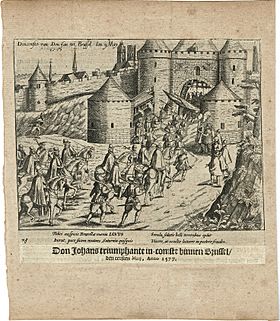
In 1576, the governor of the Spanish Netherlands died. King Philip II appointed John of Austria as the new governor-general. John arrived in Brussels in May 1577.
John captured the city of Namur in July 1577. In January 1578, he won a big victory against the Protestants at the Battle of Gembloux. This defeat forced Prince William of Orange, the leader of the revolt, to leave Brussels. John's victory also broke up the unity of the rebel provinces. However, six months later, John's forces were defeated at Rijmenam.
Death

John of Austria's health began to get worse. He became sick with a fever. He died on October 1, 1578, when he was 31 years old.
Legacy
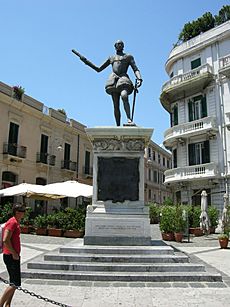
A monument to John of Austria was built in Messina, Italy, in 1572. It was put up to honor him as the winner of the Battle of Lepanto.
A copy of this statue was put up in his birthplace, Regensburg, Germany, in 1978. This was to mark 400 years since his death.
In Literature
- A character named "Don John" is a villain in William Shakespeare's play Much Ado About Nothing. He is described as the "illegitimate brother to Don Pedro".
- John of Austria's life inspired a play called Don Juan d'Autriche in 1835. This play then led to two operas.
- G. K. Chesterton wrote a poem in 1911 called Lepanto. In the poem, he called Don John "the last knight of Europe".
- The historical novel A Knight of Spain (1913) by Marjorie Bowen tells the story of John of Austria and his half-brother, Philip.
- The historical romance Spanish Lover (1930) by Frank H. Spearman has Don John as its main character.
- In 1956, Louis de Wohl published The Last Crusader: A Novel about Don Juan of Austria. This book shows John of Austria as a very inspiring hero.
|
See also
 In Spanish: Juan de Austria para niños
In Spanish: Juan de Austria para niños





